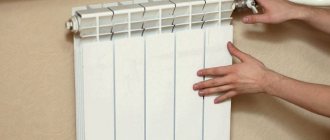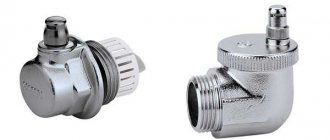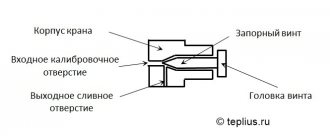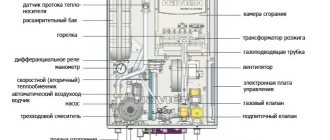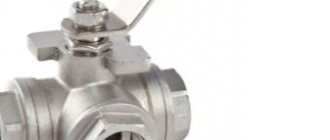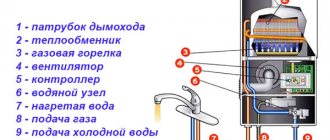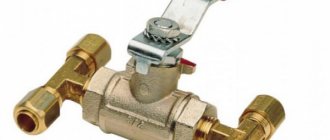Dissolved air enters the heating system along with the coolant. Accumulating in significant quantities, oxygen creates plugs that prevent normal fluid circulation. This reduces the quality of heating of the building. To eliminate airing of the system, a Mayevsky crane was designed. The principle of operation is simple and clear, so such a device is installed everywhere - be it a multi-storey building or a modest cottage.
The Mayevsky crane helps get rid of air jams in the heating network
Purpose of the Mayevsky crane
Air is lighter than water, so it accumulates at the peak points of the space heating system and radiators. This happens for several reasons:
- pipes do not fill with water quickly enough;
- the fed system was partially empty;
- There is a lot of dissolved oxygen in water.
Sometimes the accumulation of air provokes a special design of the heating system, when in certain areas loops of pipes are formed, turned upward.
In 1931, the State Planning Committee decided that during downstream installations, ordinary taps should be installed to remove air from systems. But through them, residents of houses not only eliminated air locks, but often drained hot water, which in this case acts as a coolant, and then used it for household needs - for example, to wash the floors. This was unacceptable from the standpoint of sanitation and the technology of central heating of buildings. Therefore, Mayevsky taps began to be installed on radiators, which significantly complicated the task of inappropriate use of coolant.
Installing a tap prevents water from being used for other purposes
How is the air exhaust mechanism installed?
The Mayevsky manual tap is a self-sealing device. The product kit includes an O-ring made of rubber, so there is no need to use any additional sealing materials.
Traditionally, the installation of manual valves for bleeding air of this type is performed in conjunction with radiator fittings (1 dm x ½ dm; 1 dm x ¾ dm). As an installation tool, use a spanner wrench specially designed for working with fittings and plugs.
Plumbing socket wrench for installing radiator casings and plugs. 1 – ring wrench, 2 – radiator cap, 3 – radiator cap. These tools and parts are often used when installing air vent valves
The operation of Mayevsky valves (air vents) is permissible only at the pressure and temperature values specified in the standards. These values are determined by the technical characteristics of the device.
How the Mayevsky crane works
The device was developed in 1933 by an engineer from Leningrad, Cheslav Bronislavovich Mayevsky. Officially it is called a radiator needle air valve.
According to some historical data, the crane of Minsk resident S.A. Roev first appeared. It consisted of two parts separated by a gasket. The devices were tested in 1932. A year later, Mayevsky improved this design, improving the sealing of parts. In a more modern interpretation, the engineer connected the parts using the “cone-to-cone” method.
The crane consists of the following components:
- frame;
- conical head screw;
- turning part;
- inlet and outlet channels for air.
Design of the device
The air vent device drives the locking screw. The latter is controlled with a screwdriver or manually, which depends on the specific model. In the modern version, a special key is already installed on the tap, so using the device has become easier.
Advantages of installing a Mayevsky crane:
- increasing the efficiency of the heating network;
- simplification of radiator maintenance;
- affordable cost of the unit itself.
But such a crane, despite the listed advantages, also has a drawback. Since the quality of the coolant often leaves much to be desired, blockages often occur in the tap during operation.
Depending on the design, there are three types of crane:
- radiator - intended for heating devices;
- traditional - installed everywhere, equipped with external thread;
- complete - is a ball valve with KM.
Sectional drawing of a faucet
Depending on the method of unscrewing, there are the following devices:
- for a screwdriver;
- turnkey four- or hexagonal;
- with a handle, which does not require a tool.
Various materials and their combinations are also used for manufacturing. There are CMs:
- steel;
- brass;
- cast iron;
- stainless steel;
- plastic.
Most often, the assembly is made from brass, which is resistant to corrosion, which threatens the materials due to unfavorable operating conditions. Often, unscrupulous sellers pass off cheap silumian as brass. But this material is unreliable, products made from it quickly fail.
Attention! Children love to play with various objects. Therefore, it is better to install a tap in their room that can be opened with a screwdriver. If the baby opens the tap on his own, he will get burns.
In children's rooms, it is recommended to install device models “under a screwdriver”
Automatic KM
Automatic CMs are convenient in private homes with individual heating, as they eliminate air locks and regulate the pressure independently. Inside this unit there is a chamber equipped with a float inside. This, in turn, is connected to a needle valve located at the top of the assembly.
When the air gap exceeds the set limit, the valve opens for a while, allowing air to leave the system. Then, due to the action of the float, it returns to its original position again, preventing water from flowing out.
Automatic crane model
The main advantage of AKM is that there is no need to place a container to remove air trapped inside the pipes, since water does not flow out. The tap is automatically blocked as soon as the coolant level rises. However, automatic models are more expensive than mechanical ones.
Air vents are:
- straight;
- corner;
- radiator.
Video - Mayevsky crane: what it is and how it works
Scope of application and types of cranes
Mayevsky manual valves are used for the following purposes:
- First of all, removing air bubbles from heating radiators of all types - aluminum, steel and cast iron.
- Venting air from heated towel rails.
- Periodic de-airing of problem areas of the heating network - expansion joints turned upward, bypass loops (for example, above the front door), risers and other places where air accumulates.
Installation of air bleed valves is provided by all manufacturers of modern radiators. Heating devices are supplied from the factory with fittings (plugs) with a hole for the Mayevsky valve. The battery valve is selected according to the diameter of the external pipe thread - G¼”, ½”, ¾”.
Reference. The G¼” external thread of the air valve is identical to that of a standard pressure gauge.
If you need to organize air bleed in a problem area of the system, buy a Soviet-style valve with an external metric thread M10 x 1. The pipe wall is drilled with a Ø9 mm drill, the thread is cut with a tap, then a Mayevsky valve is screwed in and the joint is sealed with plumbing flax.
Another option is to cut a tee into the main line and install a slotted valve on the outlet pipe, as done in the photo below. The method will help with a cold (air-filled) heated towel rail that does not have a thread for an air vent.
Some models of heated towel rails have a slot for an air vent (photo on the left)
The operating principle of all Mayevsky valves is the same, but commercially available products may differ in design:
- The shut-off valve is made for a slotted screwdriver, a special key, or equipped with a handle. The old version of the product uses a hex head bolt.
- The needle (cone) that covers the hole can be metal or plastic.
- The corresponding “aged” valves shown in the photo are installed on designer cast-iron batteries.
Faucets with a handle are convenient to use - the air can be easily released without any tools. On the other hand, anyone can turn the valve, including small children, which should not be allowed. Hence the recommendation - buy and install traditional products with a slot or a tetrahedral key.
Retro-style valves for designer batteries (left) and a small 1/4-inch “air vent” for a ball valve (right)
Reference. Manufacturers equip some models of ball valves with Mayevsky air vents. Here the option with a handle is more appropriate, and the valve with a G¼” thread can be removed and replaced with a pressure gauge or a plug can be installed.
Do not confuse “Mayevskie” with automatic float-type air vents. The latter are similar in principle of operation - the passage hole is also closed with a needle, but air is removed without human intervention. There are 2 types of such devices - universal (used in boiler safety groups) and radiator ones.
Valves for automatic air release - radiator and universal
Where to install the device?
The device is installed at the highest points of the premises network. However, in addition, the installation diagram of the heating network is taken into account.
The vertical method of supplying coolant requires that each radiator located on the top floor, where there is a lower supply with a return line, be equipped with a KM.
Air valves are also needed everywhere on devices in which the supply line is completely or partially below the level of the upper connection axis. Then the natural elimination of the oxygen plug becomes more difficult. In the horizontal version of the circuit, the CM is placed on each heating radiator.
Placement of Mayevsky air vent valves for both scheme options
Air valves are also installed in areas where there are bends in the pipeline. So, for example, when a pipe bends sharply upward and then descends down a short section, a pocket is formed. Airing will constantly occur in this area. The crane is installed here at the top point of the site.
The “warm floor” system in most cases also requires the installation of this equipment. Air release is most effective on the collector group, which rises above the floor level.
“Heated floor” systems are rapidly gaining popularity among owners of private country houses and city apartments. In a special article we will tell you whether it is possible to connect a “warm floor” from heating.
Mayevsky taps are also installed in the towel dryer in the bathroom. This is necessary when airing occurs regularly in the system. The manufacturer provides a hole for the valve in heated towel rails connected from below. When connecting laterally, this section of the pipe is slightly modified. Then a tee with the required thread parameters is implanted into the supply zone. Install the device, directing the outlet away from the wall.
It is important! If air constantly accumulates in the pipes, then during the next repair it is worth purchasing models of towels that are already equipped with a Mayevsky tap.
Towels with installed air vent
Types of taps by material of manufacture
In addition to the principle of operation, all Mayevsky cranes differ depending on the material used. Both metal and plastic models are extremely popular in practice.
The most famous cranes include:
- Steel products. This alloy is made by combining iron and carbon, and sometimes several other impurities. Such cranes are characterized by increased strength, low weight, and easy maintenance requirements.
- Brass, from which mechanical Mayevsky taps are most often made. This material has a high degree of resistance to corrosion and can serve for a long time without deterioration. In addition, this alloy is absolutely safe for others, for residents of a house or apartment.
- Taps made of cast iron. Cast iron has sufficient strength that allows you to use the product for a long time in everyday life. The main disadvantage is the very significant weight of the product, which creates additional load on the fastenings of the heating pipes.
Sometimes in apartments you can find a plastic tap installed on heating radiators. This model has low cost, but low strength.
Accidental damage to the structure is possible when the valves are opened excessively or when cleaning the outlet from dirt. Therefore, plastic products will have to be changed quite often.
What to look for when buying an air vent valve?
Heating systems are susceptible to water hammer. This happens rarely, but the possibility exists. Therefore, it is better to choose models with a safety valve that is sensitive to pressure changes. When the indicator reaches critical levels, the valve opens and water leaves the heating circuit.
Reference. Water hammer is a pressure difference that is caused by a sharp change in the speed of the coolant. This phenomenon leads to the formation of cracks, ruptures of pipes and radiators, as a result of which the coolant flows out of the system and floods the premises. PVC pipes are most often damaged.
It is better to choose products with rubber or silicone gaskets. There are also paronite gaskets, but they have proven to be worse. Additionally, the thread can be strengthened with linen tow or fum tape.
Water hammer in the heating system
When choosing a faucet, take into account its location and the design of the heating system itself.
Manual models of cranes are universal. When purchasing them, you must take into account the distance from the pipe on which the valve is installed to the wall. The distance is left such that the tool can be used, especially if this requires a screwdriver or pliers.
Automatic machines are not very suitable for centralized heating systems. There, the purity of the coolant raises questions, so the unit often gets clogged. Such models are not very suitable for cast iron radiators either. In the latter case, manual models in a brass case have proven themselves better. They can also be used in steam heating systems.
But AKMs are convenient in tight spaces and places with difficult access. They are also used in underfloor heating systems, since it is difficult to detect the formation of an air lock.
The Mayevsky tap will not interfere with the “warm floor” water system
When purchasing, pay attention to the thread parameters. You should also find out the type of socket on the radiator. For sale, manufacturers offer KM models equipped with a handle with a side outlet, which are more convenient than those located in the traditional way.
Also, when choosing a node, take into account the following characteristics:
- permissible pressure;
- working temperature.
Technical characteristics of the air vent
The required functional properties are presented in the following table:
| Technical specifications | Permissible value | Units |
| Pressure (working) | 10 | ATI |
| Temperature (maximum) | 120 | ºС |
| Passage diameter | 25.4 or 20.0 | mm |
| Thread diameter | 25.4 or 20.0 | mm |
| Working environment | water and other non-aggressive liquids | — |
| Life time | 20 — 25 | years |
| Leakage class | "A" | — |
During operation, malfunctions in the operation of the devices cannot be ruled out. A frequent reason for the loss of performance of Mayevsky cranes is small debris moved by the coolant.
If the faucet becomes clogged and no longer works, it is recommended to carry out simple maintenance:
- Isolate the radiator from the system with shut-off valves.
- Release approximately 1/3 of the water volume from the battery.
- Remove the device from the battery case.
- Clean the passage hole with a thin (non-metallic) sharp object.
Heating systems are not always equipped with radiators that have plugs with ready-made holes for Mayevsky taps. In such cases, the terminals for the air vents will have to be made by hand. No particular difficulties are foreseen in this matter. You just need to drill a hole for the installation size of the faucet and cut the thread.
The installation of taps in the housing of cast iron heating radiators should be given special attention. Products made from high-quality, reliable materials are traditionally used here.
The hole is drilled with a metal drill using a drill, and the thread is cut with a tap. Of course, the diameter of the drill is chosen 1 - 1.5 mm less than the installation size of the faucet, and the tap is exactly the size.
Step-by-step instructions for installing KM into the system
At the first stage, preparatory work is carried out. It is advisable to carry out the installation in the warm season, when it is possible to remove coolant from the heating system. Often in old radiators there is no special hole for the CM, so it must be drilled.
- At the first stage, the pipes are removed.
- Remove the radiator from the hooks and completely drain the water.
- On the side opposite from the pipe entrance, a hole is drilled in the top plug, the diameter of which corresponds to the purchased CM.
- The threads are cut inside according to the one used on the KM. It should be taken into account that the tap has a right-hand thread, therefore, the plug has a left-hand thread. Another option is to replace the entire plug at once.
- Then install the tap, as indicated in the instructions for the device.
- The battery is returned to its place.
- At the last stage, the pipeline is connected.
For cast iron batteries, factories produce ready-made plugs for air vent valves.
The outlet hole of the valve is directed slightly downward. This makes it easier to collect the water that should flow from the tap.
When installing the device on heating pipes made of plastic, a fitting will be required.
Attention! Valves with manual control are usually installed horizontally, automatic valves are installed vertically. The correct installation must be clarified in the instructions.
Signs of system blockage
Video - Equipping a heated towel rail with an air vent tap
Conclusions and useful video on the topic
The video demonstrates the principle of operation of the Mayevsky crane and provides recommendations for its installation:
Simple in design and easy to maintain, air vents are also an integral technical part of any heating system. Deliberate exclusion of devices from the system threatens to result in serious consequences, including defrosting of batteries and pipes in winter. It is impossible to ignore Mayevsky’s taps; they just need to be selected for a specific system.
Please write comments in the block below. Tell us about your own experience in installing mechanical air vents. Ask questions, share your opinion and photographs on the topic.
How to bleed air from a heating system?
If the coolant is driven by the circulation pump, it is turned off. At least 15 minutes must pass between stopping the equipment and starting to bleed air. During this time, oxygen will rise up.
Prepare a container that will be needed to collect water. Using a screwdriver, wrench or turning the handle, unscrew the tap until a characteristic hissing sound is heard - a sign that air is leaving the system. However, simply waiting for the hissing to stop is not enough. The water needs to flow. This means that the traffic jam has been removed. The stream should be smooth and flow without interruptions. Only after this the valve is closed.
Attention! Sometimes, even after repeated bleeding, air pockets still form. Then the cause may be a breakdown or insufficient twisting.
If the stream of water is uniform, without interruptions, then the air has been removed
Product Installation
The tap is installed in the upper part of the radiator on the side opposite to the water flow.
In a house with two or three floors, taps are installed on the top.
Additionally, air vents are installed on devices that are connected to the riser below the upper heating axis.
In a one-story house, Mayevsky taps are installed on all radiators.
In modern closed heating there is no highest point.
When installed on a floor-standing radiator, the product is placed at the highest point of the device.
Models of heated towel rails with bottom connections have space for installing an air vent.
For a heated towel rail with a side connection, a tee is installed into which the tap is screwed.
The air outlet is directed away from the wall. The design features of some models require the installation of two Mayevsky cranes.
Features of crane operation
If the device is used correctly, the entire heating system will work correctly, and undesirable consequences will be minimized.
The taps last a long time. The problematic side of operation is that they often become clogged. Then the equipment is cleaned. Use a needle for this.
The problem area can be detected independently at home without the involvement of a specialist. The method is quite simple, and you only need a piece of paper. The valve is left open to allow air to escape. Take a sheet of paper in your hands and pass it at a distance of 1 cm over all places where there are connections and along pipes and radiators. In an area where there is no seal, the paper will stick.
WD-40 will help open a faucet that has not been used for a long time
This area is carefully inspected and the cause of the air leak is determined. Then the system is serviced and the failed element is replaced.
It happens that the air vents have not been used for a long time. Then the tap thread may oxidize, making it impossible to remove air from the heating pipes. To get rid of rust, use WD-40 or similar products. Then lightly tap the surface and try to open the valve.
Types of cranes based on operating principle
The production of sanitary products does not stand still, and therefore the Mayevsky faucet now has an automatic analogue. The development of automatic taps is associated with a shortage of free space in residential premises.
In this case, pipes and radiators are placed in the most inaccessible places. For such situations, an automatic tap is used, which independently opens the valve under the influence of excess pressure.
How to choose
Mayevsky taps are produced with two thread sizes - ½ and ¾ inches. To embed the valve into the plug of a cast iron radiator, you need to make a threaded hole in it that is the same size as the thread of the air vent. This can be done in a workshop or with your own hands if you have the appropriate tools.
On the heating equipment market you can purchase a repair kit with plugs (foot caps) ready for insertion into Mayevsky taps. You just need to select the appropriate thread diameter.
There are air vents with an adjusting screw for a screwdriver and a wrench. It is more convenient to use a faucet with a rotating plastic handle. Automatic air vents are purchased by housing offices and other business organizations for installation in public premises, buildings and structures. They are rarely embedded in cast iron batteries.
Rules of service
Uninterrupted operation of the drain valve is possible only if the rules for its operation are observed:
- To bleed air, open the tap. If the air flow does not stop after a few minutes, it means that there is an additional suction in the system. To check the tightness, take a thin sheet of paper and pass it around all the joints. In places where there is suction, the sheet will be drawn to the joint.
- If the exhaust channel is dirty, clean it with a thin needle or wire.
- With infrequent use, the faucet becomes corroded and stops working. To correct the situation, treat the faucet with WD-40. For preventive purposes, after the end of the season, the threads should be treated with silicone grease.
- The faucet cannot be repaired and must be replaced if broken. Dismantling must be done using an auxiliary adjustable wrench to fix the radiator cap. Otherwise, the radiator itself may be damaged.
Questions and answers
If the tap was not on the riser (or it was the first shut-off device after the riser) and was installed without approval, then the owner is responsible for it, according to Art. 210 of the Civil Code of the Russian Federation.
Installing a faucet only helps remove air. If the battery is not connected correctly (this happens with a top connection) or is clogged, this procedure most likely will not help.
A special seal is responsible for the tightness of the valve, and wear may be the cause of the leak. In this case, you will need to replace the seal or the entire valve. If drops occur in the thread area, the tap must be tightened with a wrench for a tighter fit. The leak may be due to a blockage.
If the heating system is working properly and there is enough coolant inside, the reason is that the tap hole is clogged. It needs to be cleaned or the tap replaced.
Installing a Mayevsky crane on a heating system significantly simplifies its operation and increases operating efficiency.
The installation process is not complicated and can easily be done with your own hands. But selecting the appropriate valve model requires the use of some knowledge, so it is better to consult with specialists. During operation, it is important to follow the rules and periodically carry out preventive maintenance to maintain the functionality of the mechanism.
Prevention methods
In order not to constantly bleed air from the radiators, it is necessary to perform all actions correctly when starting the heating system. The open type of system provides for independent filling of pipes with coolant. To do this, open all the valves, ensuring the unhindered movement of water.
The pressure should not be too great. It is recommended to pay attention to the drain valve, which must be closed when filling the radiators. If the heating system is closed, the algorithm is slightly different. The first step is to close all the valves except the one that starts the water. Next, you should connect a pump that ensures stable pressure in the pipes. The next step is to fill the system with coolant. Only after this should you bleed air from the radiators using a Mayevsky tap.
Air in the radiator is a common problem in houses and apartments , preventing normal heating of the room. If you follow the recommendations of specialists, an ordinary person without professional skills can cope with it.
How to understand that the battery is airy
Signs of air locks appear immediately. Here you don’t need to be a great specialist to understand that it is necessary to get rid of air in the heating radiator by bleeding it.
Cold areas of the battery indicate the presence of air.
You can recognize the airing of the heating by the following signs:
- Air serves as a kind of heat insulator. In the place where it accumulates inside the battery, the sections are not heated by the coolant. The areas can be easily identified by touching the radiator with the palm of your hand.
- The presence of air will be indicated by gurgling in the radiators when the heating is on.
- Autonomous heating of a closed type is equipped with a pressure gauge. If the measuring device shows a drop in pressure in the system, then it does not occur without a special reason. Probably, a leak appeared somewhere due to depressurization of the unit. Naturally, as the coolant flows out, air penetrates into the system.
If one of the reasons appears, you need to bleed the air from the radiator in the apartment, after which the heating will be restored.
Important! The reason for the battery cooling may be that one of the supply pipes is clogged with rust or dirt. If, when draining from the Mayevsky tap, a strong stream of water flows without pops of air, then the problem is not airing.
The danger of air jams
Such air congestion significantly reduces the heating efficiency of heating devices, which negatively affects the overall temperature in the apartment.
The most obvious sign of a traffic jam is gurgling, knocking, or babbling in the pipes when water is poured into the heating pipes. For owners of private houses with heating boilers, if you hear such sounds, bleed the air from the radiators, otherwise this will lead to damage to the boiler. If the heating of the battery surface is uneven, lightly tap the battery surface with a metal object. In those places where air accumulates, the sound of the impact will be loud and resonant.
Prolonged contact between the battery metal and the air inside leads to corrosive deposits, which will then cause the device to fail. These are the main reasons why it is advised to bleed the air from the battery as quickly as possible.
